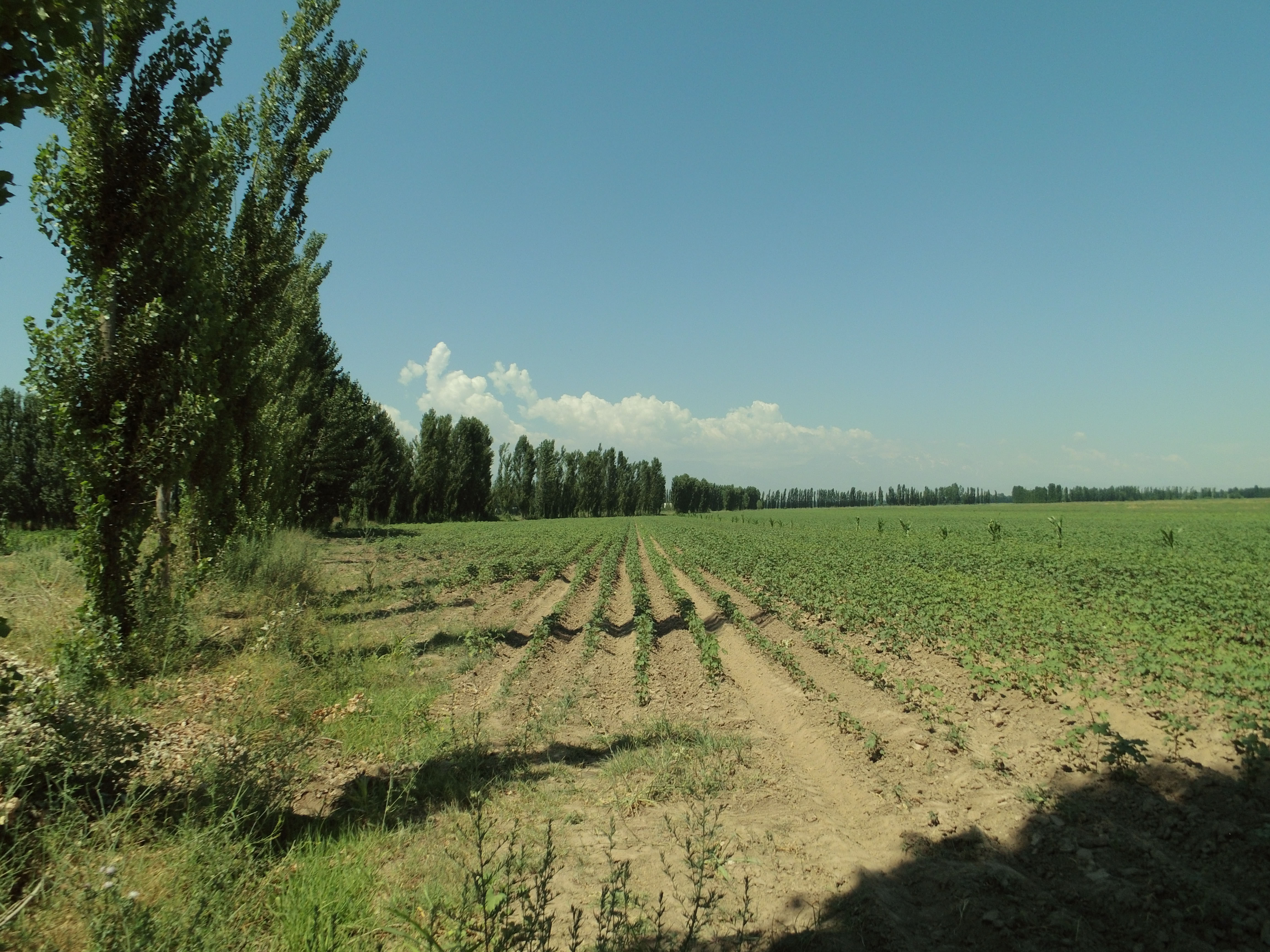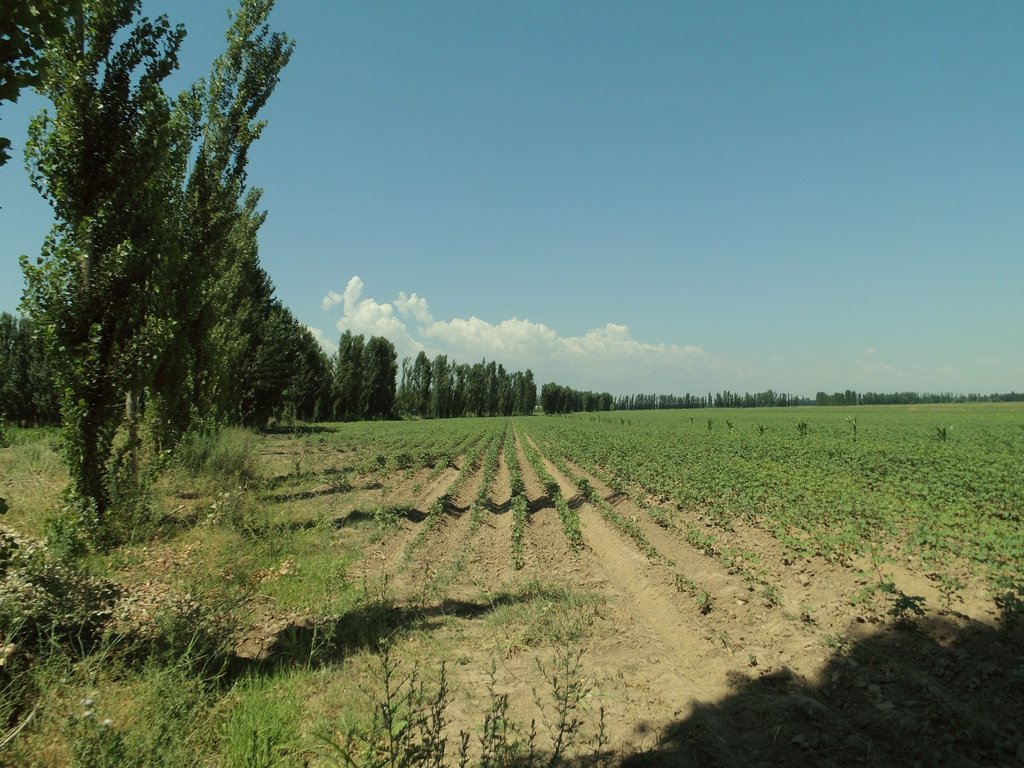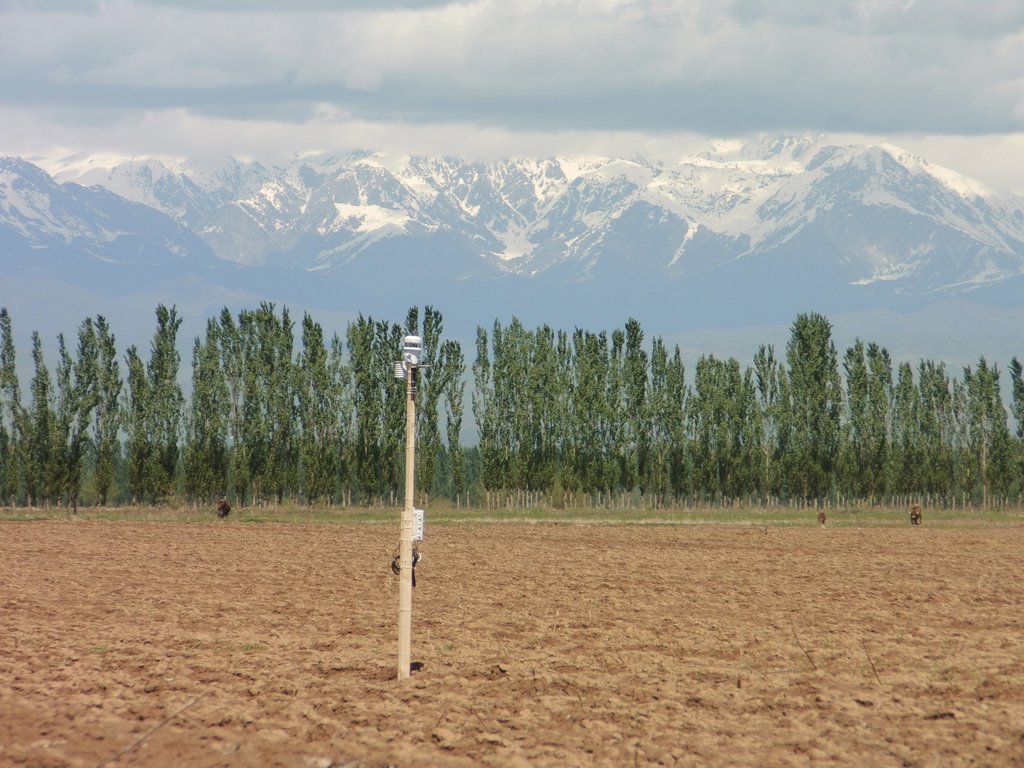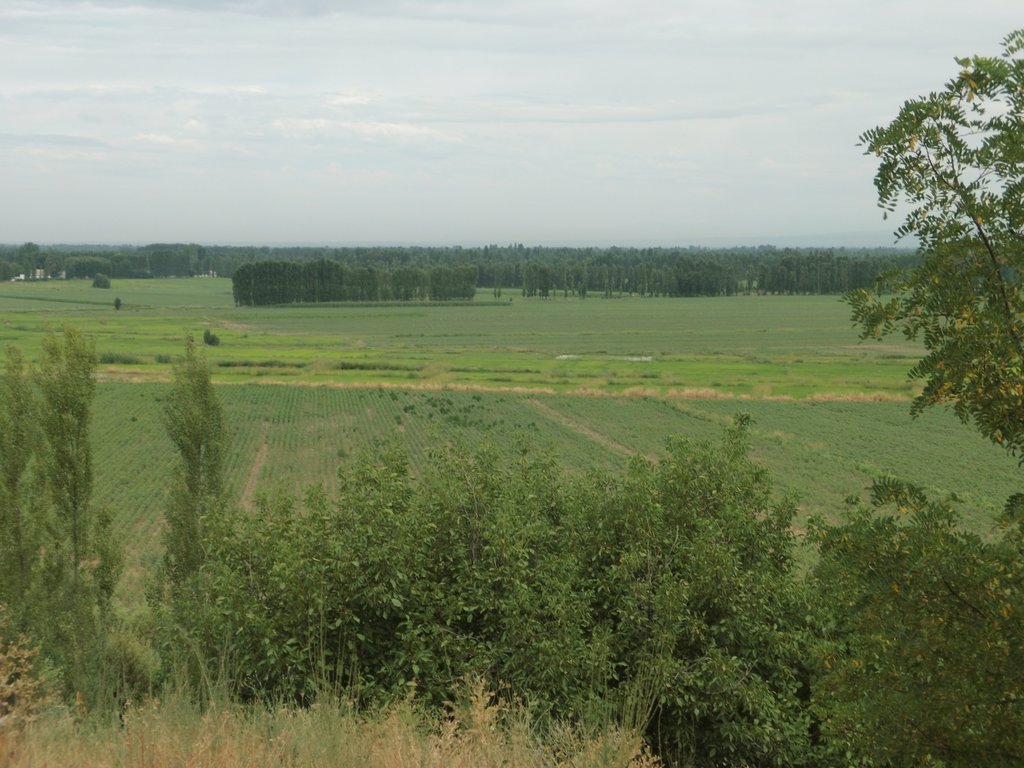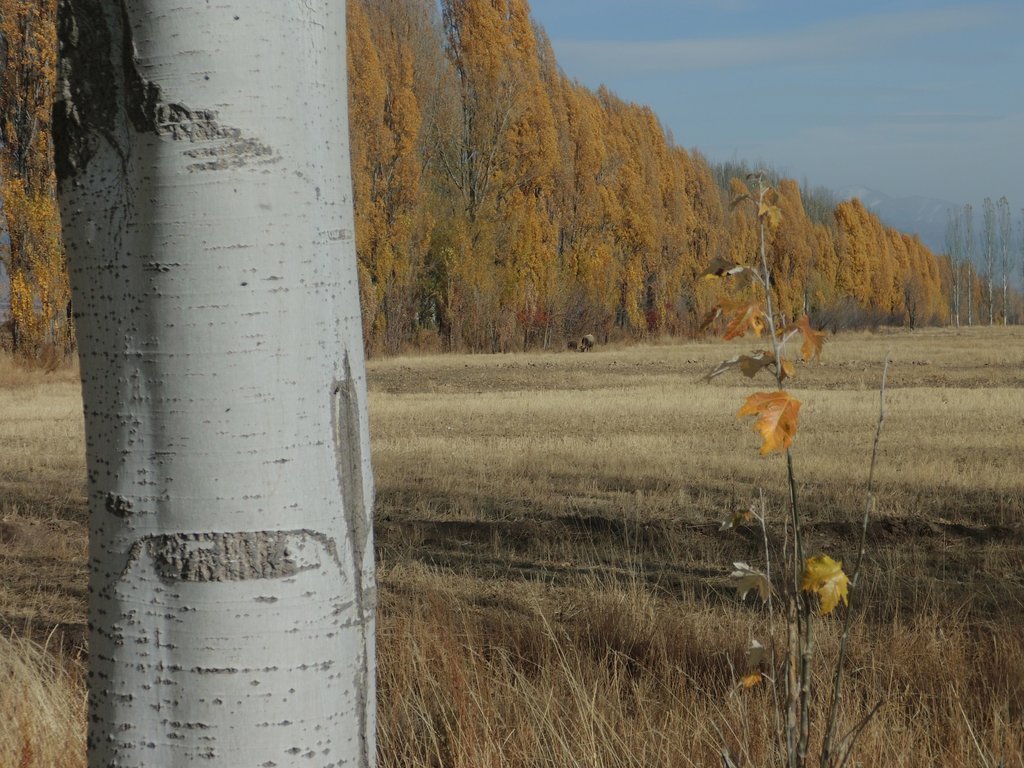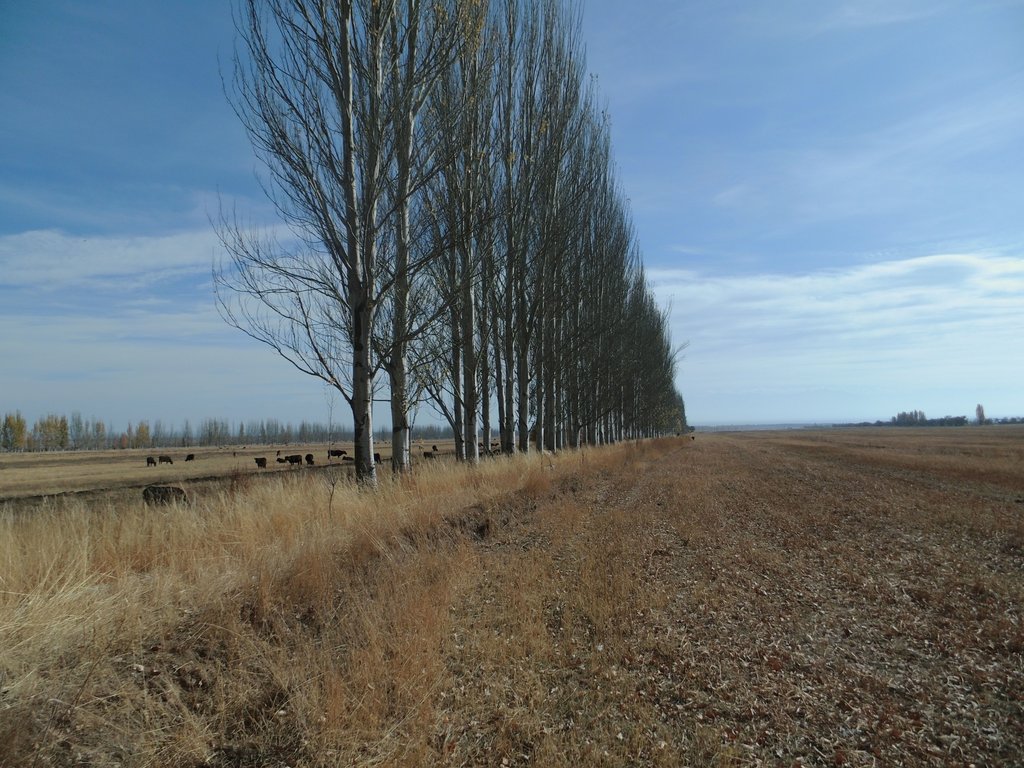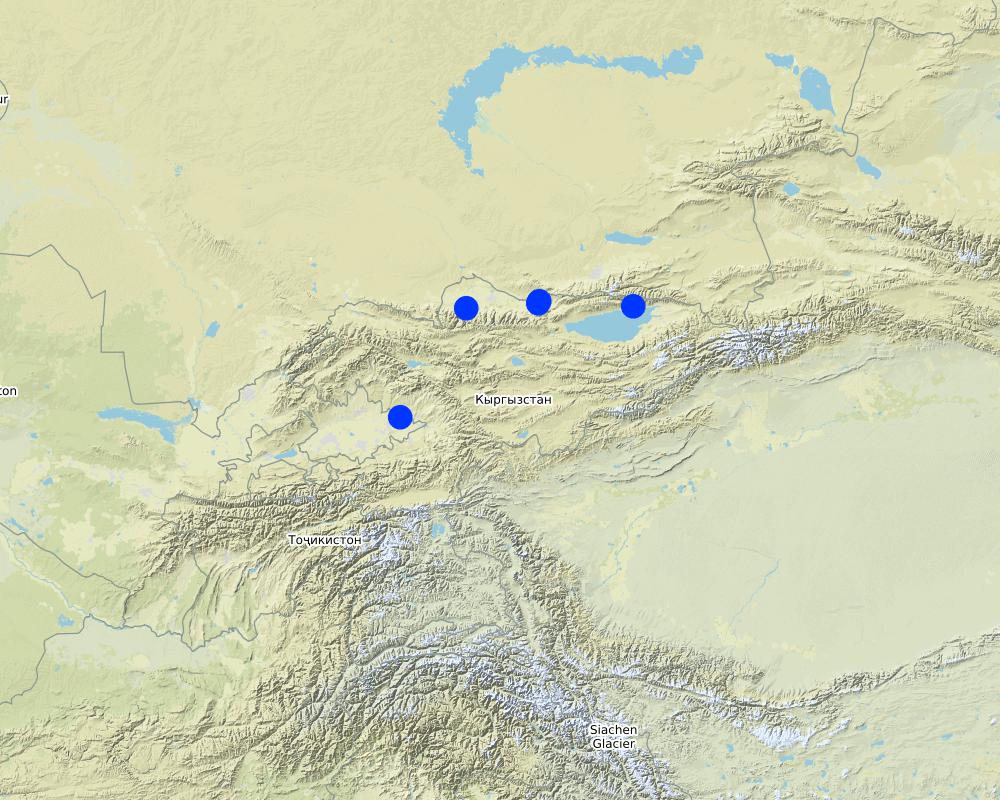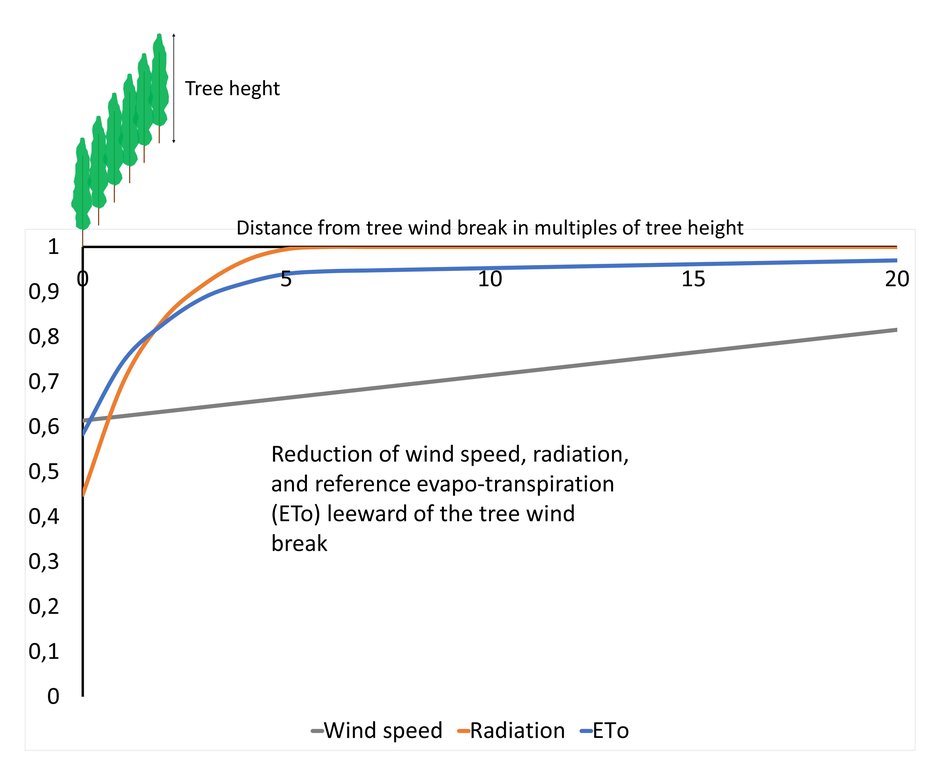Tree windbreaks within irrigated agriculture in Central Asia [Kirghizistan]
- Création :
- Mise à jour :
- Compilateur : Niels Thevs
- Rédacteur : –
- Examinateurs : William Critchley, Rima Mekdaschi Studer
technologies_5861 - Kirghizistan
Voir les sections
Développer tout Réduire tout1. Informations générales
1.2 Coordonnées des personnes-ressources et des institutions impliquées dans l'évaluation et la documentation de la Technologie
Nom du ou des institutions qui ont facilité la documentation/ l'évaluation de la Technologie (si pertinent)
International Centre for Research in Agroforestry (ICRAF) - Kenya1.3 Conditions relatives à l'utilisation par WOCAT des données documentées
Le compilateur et la(les) personne(s) ressource(s) acceptent les conditions relatives à l'utilisation par WOCAT des données documentées:
Oui
1.4 Déclaration sur la durabilité de la Technologie décrite
Est-ce que la Technologie décrite ici pose problème par rapport à la dégradation des terres, de telle sorte qu'elle ne peut pas être déclarée comme étant une technologie de gestion durable des terres?
Non
1.5 Référence au(x) Questionnaires sur les Approches de GDT (documentées au moyen de WOCAT)
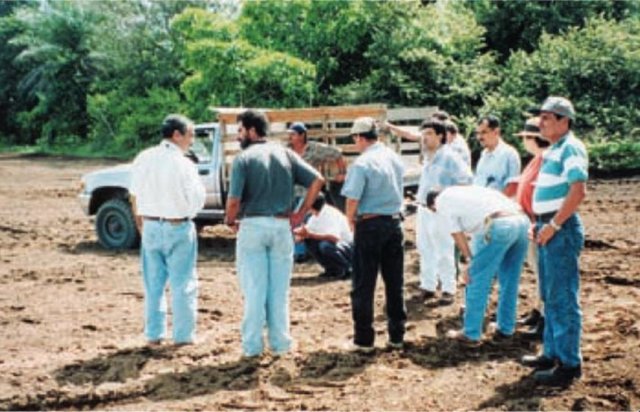
Agroforestry extension [Costa Rica]
Participatory extension of agroforestry systems, especially of shadegrown coffee, to promote sustainable and productive use of natural resources among small and medium scale farmers.
- Compilateur : Olman Quiros Madrigal
2. Description de la Technologie de GDT
2.1 Courte description de la Technologie
Définition de la Technologie:
Windbreaks of poplar trees (Populus nigra pyramidalis) are a major agroforestry system in irrigated agriculture across Central Asia. Such windbreaks reduce the overall water consumption of irrigated agriculture by 10-20% and increase farm income by 10-15%.
2.2 Description détaillée de la Technologie
Description:
Windbreaks of trees are a major agroforestry system across Central Asia. The SLM technology presented here concentrates on windbreaks, chiefly of poplar trees (Populus nigra var. pyramidalis), within irrigated agriculture. These windbreaks of poplars have a long tradition as an agroforestry system in irrigated agriculture in the river basins of south and southeastern Kazakhstan, Kyrgyzstan, Tajikistan, Turkmenistan, and Uzbekistan. In Kazakhstan and northern parts of Kyrgyzstan, poplars are partly replaced by Elm (Ulmus minor) windbreaks.
After those five countries had become independent, a large share of the windbreaks was cut down primarily for fuelwood and secondarily for timber, as the energy supply system had broken down in the course of the disintegration of the Soviet Union. Such windbreaks reduce the overall water consumption of irrigated agriculture by 10-20% compared to open field conditions, depending on crops and tree spacing (Thevs et al., 2019: doi:10.3390/land8110167). The trees serve as an additional source of income, chiefly from sustainable harvest of the trees for timber. Windbreaks also help to increase crop yields. In total, farm income is increased by 10-15% over the rotation period of the trees (Thevs and Aliev, 2021: https://doi.org/10.1007/s10457-021-00617-7). The rotation period of poplars is between 12 and 20 years, depending on the climatic conditions, e.g. poplars in the Ferghana Valles reach DBH (diametre at breast height) values of 22-27 cm and tree heights of 18 m after 13 years.
In this recent assessment, it was found that windbreaks of single tree rows with distances between trees of 1 m had the best effects on water saving and increasing farm income. The most suitable spacing between windbreaks was found to be around 200 m.
Windbreaks are perceived differently by land users depending on the region and knowledge (Ruppert et al., 2020: doi:10.3390/su12031093). For example, land users in the Ferghana Valley perceived windbreaks positively and were planting them primarily with the aim to have wood resources in the near future. In contrast, land users in the northern part of Kyrgyzstan were afraid firstly that windbreaks shaded their crops, consumed space, and competed for water and nutrients, and secondly that planting windbreaks may cause conflicts with neighbours due to those negative connotations. Farmers with larger field plots were more open towards them.
Windbreaks are planted with 2-year-old poplar saplings, which are locally available. The preferred place to plant is along irrigation ditches or other existing field boundaries. If windbreaks are planted along irrigation ditches, they simply tap water from the moist soil or elevated groundwater adjacent to those ditches. Otherwise, the trees need to be irrigated like the crops. As furrow irrigation is the dominant irrigation practice throughout Central Asia, poplars can be integrated without further adjustments in the field of irrigation. Alongside irrigation ditches poplars can withstand high water levels in those ditches as they occur during irrigation periods. If farmers switch to drip irrigation, and irrigation ditches are no longer present, the trees will need to be supplied with a dripline as well. The locally available poplar cultivars do not need additional fertilizer, but profit from the fertilizer applied to the crop. Only if high yielding modern cultivars were to be used, additional fertilizer application to the trees would be needed to unfold their full potential.
2.3 Photos de la Technologie
2.4 Vidéos de la Technologie
Commentaire, brève description:
Video on Youtube: https://www.youtube.com/watch?v=2mAfQzO7MHg
This video provides a concise introduction into tree wind breaks, including their advantages with regards to water consumption, building resiliance against climate change, and income.
Date:
01/09/2019
Lieu:
Ferghana Valley, Kyrgyzstan
Nom du vidéaste:
Gino Carlo Garcia
Commentaire, brève description:
This video on Youtube, https://www.youtube.com/watch?v=Iv0VdPqBT9o, is part of a series on poplars. This part focusses on tree wind breaks with many statements of local acteurs. The other parts of this series introduce high yielding poplar cultivars and their options in agroforestry, woodlints, and value chains.
Date:
01/02/2020
Lieu:
Kyrgyzstan
Nom du vidéaste:
Lea Gerster and Stefanie Breunlich
2.5 Pays/ région/ lieux où la Technologie a été appliquée et qui sont couverts par cette évaluation
Pays:
Kirghizistan
Région/ Etat/ Province:
Jalalabad Region, Chui Region, and Issyk Kul Region
Spécifiez la diffusion de la Technologie:
- répartie uniformément sur une zone
S'il n'existe pas d'informations exactes sur la superficie, indiquez les limites approximatives de la zone couverte:
- 0,1-1 km2
Est-ce que les sites dans lesquels la Technologie est appliquée sont situés dans des zones protégées en permanence?
Non
Commentaires:
Windbreaks are spread over large areas, but the spatial distribution can be described as pockets of between 10 and 1000 ha. Within those pockets, tree wind breaks are sometimes interrupted. Also outside those pockets with more or less contiguous windbreaks systems there are remnants of those systems.
Map
×2.6 Date de mise en œuvre de la Technologie
Si l'année précise est inconnue, indiquez la date approximative: :
- il y a entre 10-50 ans
2.7 Introduction de la Technologie
Spécifiez comment la Technologie a été introduite: :
- dans le cadre d'un système traditionnel (> 50 ans)
3. Classification de la Technologie de GDT
3.1 Principal(aux) objectif(s) de la Technologie
- améliorer la production
- s'adapter au changement et aux extrêmes climatiques et à leurs impacts
- créer un impact économique positif
3.2 Type(s) actuel(s) d'utilisation des terres, là où la Technologie est appliquée
Les divers types d'utilisation des terres au sein du même unité de terrain: :
Oui
Précisez l'utilisation mixte des terres (cultures/ pâturages/ arbres):
- Agroforesterie

Terres cultivées
- Cultures annuelles
- Plantations d’arbres ou de buissons
Cultures annuelles - Précisez les cultures:
- céréales - orge
- céréales - maïs
- céréales - riz (de terres humides)
- céréales - blé de printemps
- céréales - blé d'hiver
- cultures de plantes à fibres - coton
- cultures fourragères - luzerne
- plantes à racines et à tubercules - pommes de terre
- Poplars
Nombre de période de croissance par an: :
- 1
Est-ce que les cultures intercalaires sont pratiquées?
Non
Est-ce que la rotation des cultures est appliquée?
Non
3.3 Est-ce que l’utilisation des terres a changé en raison de la mise en œuvre de la Technologie ?
Est-ce que l’utilisation des terres a changé en raison de la mise en œuvre de la Technologie ?
- Non (Passez à la question 3.4)
Les divers types d'utilisation des terres au sein du même unité de terrain: :
Oui
Précisez l'utilisation mixte des terres (cultures/ pâturages/ arbres):
- Agroforesterie
3.4 Approvisionnement en eau
Approvisionnement en eau des terres sur lesquelles est appliquée la Technologie:
- pleine irrigation
Commentaires:
As the spatial distribution stretches over large parts of Central Asia, some locations where windbreaks are planted are rainfed and irrigated, but most parts need full irrigation.
3.5 Groupe de GDT auquel appartient la Technologie
- agroforesterie
- brise-vent/ plantations abris
3.6 Mesures de GDT constituant la Technologie

pratiques végétales
- V1: Couverture d’arbres et d’arbustes
3.7 Principaux types de dégradation des terres traités par la Technologie

érosion éolienne des sols
- Et: perte de la couche superficielle des sols (couche arable)

dégradation hydrique
- Ha: aridification
- Hg: changement du niveau des nappes phréatiques (eaux souterraines) et des aquifères
Commentaires:
The main effect of windbreaks in the assessed areas is mainly reducing water consumption, and less wind erosion. Poplars could help to lower groundwater levels and thus contribute to combat salinization. But that did not play a role in the areas specifically assessed.
3.8 Prévention, réduction de la dégradation ou réhabilitation des terres dégradées
Spécifiez l'objectif de la Technologie au regard de la dégradation des terres:
- réduire la dégradation des terres
4. Spécifications techniques, activités, intrants et coûts de mise en œuvre
4.1 Dessin technique de la Technologie
Spécifications techniques (associées au dessin technique):
Windbreaks have their greatest impact when planted perpendicular to the main wind direction (or direction of the strongest winds). A whole grid of tree wind breaks running along all field plot borders will have a greater effect, as it prevents enhanced winds through a tunnel effect under changing wind directions. Tree wind breaks can be planted with distances of 50 m to 1000 m away from each other. The effect on the micro climate becomes less pronounced with increasing distance from tree wind breaks. Therefore, on a large field plot, say of 1000 m width between windbreaks, the micro climate averaged over the field plot will not differ much from the conditions without tree wind breaks. In contrast, on smaller field plots, say of 100 m width between windbreaks, the micro climate will differ significantly from open field conditions. This is also explained by the lines for temperature, air humidity, radiation, and in particular wind speed along an increasing distance from a given windbreak. Thereby, the distance from the windbreak is given in multiples of tree height.
In total, the best effects with regard to economic return and reduced water consumption come with a spacing of 200 m between tree wind breaks.
The best effects with regard to economic return and reduced water consumption were achieved with single tree lines. So, only one line of poplar trees is planted along the field borders. The planting distance between trees is 1 m to 1.20 m.
Poplar trees are locally available as trees with a length of 2 m to 2.50 m. Those trees are planted, best along the small irrigation ditches that run along the field borders. The local cultivar which is mainly used is a Populus nigra var. pyramidalis cultivar under the local name Mirza Terek. In principle, modern high yielding cultivars can be used as well; first research has shown a 2-3 times faster growth compared to the locally available cultivars at similar water and nutrient requirements.
Auteur:
Niels Thevs
Date:
25/03/2021
4.2 Informations générales sur le calcul des intrants et des coûts
Spécifiez la manière dont les coûts et les intrants ont été calculés:
- par superficie de la Technologie
Indiquez la taille et l'unité de surface:
1 ha
autre/ monnaie nationale (précisez):
KGS
Indiquez le taux de change des USD en devise locale, le cas échéant (p.ex. 1 USD = 79.9 réal brésilien): 1 USD = :
68,87
Indiquez le coût salarial moyen de la main d'œuvre par jour:
750
4.3 Activités de mise en place/ d'établissement
| Activité | Calendrier des activités (saisonnier) | |
|---|---|---|
| 1. | Tree planting | March (first year) |
| 2. | Maintenance of trees | April to September (first and second year) |
| 3. | Harvest of trees | December to February (last year of tree rotation - after 15 years) |
Commentaires:
These entries refer to a windbreak system of poplars to be harvested at tree age of 15 years combined with cotton. Thereby, the activities related to trees, including the harvest, are considered as activities to establish windbreaks into an agrarian landscape where irrigated agriculture is ongoing. The annual crop related activities are therefore listed under maintenance. If cotton is rotated with corn or rice, the timing of the crop-related activities is similar.
4.4 Coûts et intrants nécessaires à la mise en place
| Spécifiez les intrants | Unité | Quantité | Coûts par unité | Coût total par intrant | % des coût supporté par les exploitants des terres | |
|---|---|---|---|---|---|---|
| Main d'œuvre | Labor costs for tree planting and maintenance (first year) | man-days | 3,0 | 750,0 | 2250,0 | 100,0 |
| Main d'œuvre | Labor costs for tree maintenance (second year) | man-days | 3,0 | 650,0 | 1950,0 | 100,0 |
| Equipements | Labor costs to harvest trees (at tree age 15 years) | man-days | 3,0 | 70,0 | 210,0 | 100,0 |
| Matériel végétal | Poplar saplings | sapling | 116,0 | 20,0 | 2320,0 | 100,0 |
| Matériel végétal | Transport of saplings | 500,0 | 1,0 | 500,0 | 100,0 | |
| Coût total de mise en place de la Technologie | 7230,0 | |||||
| Coût total de mise en place de la Technologie en dollars américains (USD) | 104,98 | |||||
Commentaires:
Costs had been retrieved for the year 2017. Costs that appear in the second year and later were discounted at a discount rate of 17.5% based on costs as of 2017.
4.5 Activités d'entretien/ récurrentes
| Activité | Calendrier/ fréquence | |
|---|---|---|
| 1. | Soil preparation and sowing of annual crop (cotton) | March to April / every year |
| 2. | Irrigation, fertilizer application and other farm operations for the crop | April to August / every year |
| 3. | Harvest of the crop (cotton) | September to October / every year |
4.6 Coûts et intrants nécessaires aux activités d'entretien/ récurrentes (par an)
| Spécifiez les intrants | Unité | Quantité | Coûts par unité | Coût total par intrant | % des coût supporté par les exploitants des terres | |
|---|---|---|---|---|---|---|
| Main d'œuvre | Labor costs for soil preparation | man-days | 6,81 | 750,0 | 5107,5 | 100,0 |
| Main d'œuvre | Labor costs for sowing | man-days | 2,5 | 750,0 | 1875,0 | 100,0 |
| Equipements | Labor costs for irrigation | man-days | 23,64 | 750,0 | 17730,0 | 100,0 |
| Equipements | Labor costs to apply fertilizer and plant protection | man-days | 3,34 | 750,0 | 2505,0 | 100,0 |
| Equipements | Labor costs for harvest (cotton) | man-days | 32,78 | 554,0 | 18160,12 | 100,0 |
| Equipements | Machine costs (rent) for soil preparation | ha | 1,0 | 10021,0 | 10021,0 | 100,0 |
| Equipements | Machine costs (rent) for sowing | ha | 1,0 | 1316,0 | 1316,0 | 100,0 |
| Equipements | Machine costs for fertilizer application | ha | 1,0 | 1200,0 | 1200,0 | 100,0 |
| Matériel végétal | Seeds | kg | 50,0 | 101,0 | 5050,0 | 100,0 |
| Engrais et biocides | Fertilizer | kg | 375,0 | 19,25 | 7218,75 | 100,0 |
| Engrais et biocides | Plant protection | ha | 1,0 | 1517,0 | 1517,0 | 100,0 |
| Autre | Water fee | ha | 1,0 | 1014,0 | 1014,0 | 100,0 |
| Coût total d'entretien de la Technologie | 72714,37 | |||||
| Coût total d'entretien de la Technologie en dollars américains (USD) | 1055,82 | |||||
4.7 Facteurs les plus importants affectant les coûts
Décrivez les facteurs les plus importants affectant les coûts :
Labour costs are the largest single cost item. In fact, in the cotton system a lot of labour is unpaid family labour or mutual help among neighbours. All labour was calculated in monetary terms, as the share of unpaid labour differed much between farms. This cotton tree wind break system is wide spread in the south of Kyrgyzstan. In the north of the country, tree wind breaks are combined with wheat, barley, corn, or alfalfa (lucerne). There, labour costs are lower as more machines are used (e.g. for harvest).
5. Environnement naturel et humain
5.1 Climat
Précipitations annuelles
- < 250 mm
- 251-500 mm
- 501-750 mm
- 751-1000 mm
- 1001-1500 mm
- 1501-2000 mm
- 2001-3000 mm
- 3001-4000 mm
- > 4000 mm
Spécifications/ commentaires sur les précipitations:
Precipitation maximum during spring and dry summers, which makes irrigation necessary.
Indiquez le nom de la station météorologique de référence considérée:
Bazarkorgon, Kara Balta, Kemin
Zone agro-climatique
- semi-aride
hot continental and semi-arid
5.2 Topographie
Pentes moyennes:
- plat (0-2 %)
- faible (3-5%)
- modéré (6-10%)
- onduleux (11-15%)
- vallonné (16-30%)
- raide (31-60%)
- très raide (>60%)
Reliefs:
- plateaux/ plaines
- crêtes
- flancs/ pentes de montagne
- flancs/ pentes de colline
- piémonts/ glacis (bas de pente)
- fonds de vallée/bas-fonds
Zones altitudinales:
- 0-100 m
- 101-500 m
- 501-1000 m
- 1001-1500 m
- 1501-2000 m
- 2001-2500 m
- 2501-3000 m
- 3001-4000 m
- > 4000 m
Commentaires et précisions supplémentaires sur la topographie:
Tree windbreaks can be applied in a wide range of topographical situations. Though this particular entry focusses on windbreaks in irrigated agriculture so that the whole SLM technique, i.e. trees and crops, is distributed on flat land. As irrigation is tied to rivers as water sources, this SLM technique is distributed on river plains.
5.3 Sols
Profondeur moyenne du sol:
- très superficiel (0-20 cm)
- superficiel (21-50 cm)
- modérément profond (51-80 cm)
- profond (81-120 cm)
- très profond (>120 cm)
Texture du sol (de la couche arable):
- moyen (limoneux)
Texture du sol (> 20 cm sous la surface):
- moyen (limoneux)
Matière organique de la couche arable:
- moyen (1-3%)
Si disponible, joignez une description complète du sol ou précisez les informations disponibles, par ex., type de sol, pH/ acidité du sol, capacité d'échange cationique, azote, salinité, etc.
Tree windbreaks per se are not limited to specific soil types. In the region considered here, the soils that are irrigated and therefore are sites for this SLM technique were mostly formed by riparian deposits. Those soils silty to loamy. On most of those areas, where irrigation takes place, soils are classified as Fluvisols. On few areas, the soils are classified as Gleysols.
5.4 Disponibilité et qualité de l'eau
Profondeur estimée de l’eau dans le sol:
< 5 m
Disponibilité de l’eau de surface:
bonne
Qualité de l’eau (non traitée):
uniquement pour usage agricole (irrigation)
La qualité de l'eau fait référence à:
eaux de surface
La salinité de l'eau est-elle un problème? :
Non
La zone est-elle inondée?
Non
Commentaires et précisions supplémentaires sur la qualité et la quantité d'eau:
Soil salinization and waterlogging do not play a role on the sites from where the information was collected for this introduction here. Though in parts of Kazakhstan, Uzbekistan, and Turkmenistan, where this windbreak SLM technology is being applied and can be expanded as well, salinization and water logging do play a role.
5.5 Biodiversité
Diversité des espèces:
- moyenne
Diversité des habitats:
- moyenne
5.6 Caractéristiques des exploitants des terres appliquant la Technologie
Sédentaire ou nomade:
- Sédentaire
Orientation du système de production:
- exploitation mixte (de subsistance/ commerciale)
Revenus hors exploitation:
- 10-50% de tous les revenus
Niveau relatif de richesse:
- moyen
Individus ou groupes:
- individu/ ménage
- groupe/ communauté
Niveau de mécanisation:
- travail manuel
- mécanisé/ motorisé
Genre:
- hommes
Age des exploitants des terres:
- personnes d'âge moyen
Indiquez toute autre caractéristique pertinente des exploitants des terres:
In Kyrgyzstan, the land users operate as households and can decide on their crops. Though, planting tree windbreaks does take place in agreement with neighbours. In Uzbekistan, where windbreaks are used as well, the freedom of farmers to chose their crops is limited, while tree windbreak planting partly follows governmental orders. In both countries as well as Tajikistan, labour migration is important for most rural families and remittances comprise a substantial share of the household income (off-farm income).
5.7 Superficie moyenne des terres utilisées par les exploitants des terres appliquant la Technologie
- < 0,5 ha
- 0,5-1 ha
- 1-2 ha
- 2-5 ha
- 5-15 ha
- 15-50 ha
- 50-100 ha
- 100-500 ha
- 500-1 000 ha
- 1 000-10 000 ha
- > 10 000 ha
Cette superficie est-elle considérée comme de petite, moyenne ou grande dimension (en se référant au contexte local)?
- moyenne dimension
5.8 Propriété foncière, droits d’utilisation des terres et de l'eau
Propriété foncière:
- individu, avec titre de propriété
Droits d’utilisation des terres:
- loué
- individuel
Droits d’utilisation de l’eau:
- communautaire (organisé)
Est-ce que les droits d'utilisation des terres sont fondés sur un système juridique traditionnel?
Oui
5.9 Accès aux services et aux infrastructures
santé:
- pauvre
- modéré
- bonne
éducation:
- pauvre
- modéré
- bonne
assistance technique:
- pauvre
- modéré
- bonne
emploi (par ex. hors exploitation):
- pauvre
- modéré
- bonne
marchés:
- pauvre
- modéré
- bonne
énergie:
- pauvre
- modéré
- bonne
routes et transports:
- pauvre
- modéré
- bonne
eau potable et assainissement:
- pauvre
- modéré
- bonne
services financiers:
- pauvre
- modéré
- bonne
6. Impacts et conclusions
6.1 Impacts sur site que la Technologie a montrés
Impacts socio-économiques
Production
production agricole
Commentaires/ spécifiez:
There is agreement in the scientific literature that tree windbreaks cause crop yield increases of 10-15%. Some references even claim crop yield increases of up to 40%.
production fourragère
Commentaires/ spécifiez:
The leaves of the trees are partly used as fodder. But that additional fodder only is a minor contribution to the overall fodder demand.
production de bois
Quantité avant la GDT:
none
Quantité après la GDT:
53 m³/ha after 15 years
Commentaires/ spécifiez:
Trees are harvested at an age of 15 years. Such trees have an average tree height and DBH of 19 m and 27 cm, respectively. Given a form factor of 0.42 one tree yields a stem volume of 0.457 m³. A number of 116 trees is assigned to 1 ha, which results in 53 m³/ha.
surface de production
Quantité avant la GDT:
1 ha cropland
Quantité après la GDT:
0.9 ha cropland
Commentaires/ spécifiez:
Tree wind breaks occupy space so that the area available to the crop gets reduced. While the trees do not occupy substantial space during their first years of growth, they occupy about 10% of the cropland at and age of 10-15 years. This calculation was made for a spacing between tree wind breaks of 200 m.
gestion des terres
Commentaires/ spécifiez:
Tree windbreaks at a spacing of 200 m do not impede farm operations, while narrower spacing may disturb farm operations, in particular with machines.
Disponibilité et qualité de l'eau
demande pour l'eau d'irrigation
Quantité avant la GDT:
904 mm over the cropping season
Quantité après la GDT:
777 mm over the cropping season
Commentaires/ spécifiez:
ETc (water consumption) of cotton is 904 mm over the whole cropping season. Tree windbreaks (arranged as a rectangular grid with a spacing of 200 m) with cotton together consume 777 mm over the whole cropping season. (cf. comment below under evaporation)
Revenus et coûts
dépenses pour les intrants agricoles
Commentaires/ spécifiez:
There are expenses for tree planting material and labour associated to tree planting and maintenance during the first and second year.
revenus agricoles
Quantité avant la GDT:
Accumulated NPV after 15 years: 214,000 KSG/ha
Quantité après la GDT:
Accumulated NPV after 15 years: 232,000 KSG/ha
Commentaires/ spécifiez:
The accumulated NPV over 15 years for cotton versus cotton and tree wind breaks were compared to assess the financial gain from tree wind break systems. 15 years is the tree age at which the tree wind breaks are harvested. Costs and revenues were discounted at a discount rate of 17.5%.
diversité des sources de revenus
Commentaires/ spécifiez:
Wood resources are added as additional income next to crops.
Impacts écologiques
Cycle de l'eau/ ruissellement
évaporation
Quantité avant la GDT:
904 mm over the cropping season
Quantité après la GDT:
777 mm over the cropping season
Commentaires/ spécifiez:
ETc (water consumption) of cotton is 904 mm over the whole cropping season. Tree win breaks (arranged as a rectangular grid with a spacing of 200 m) with cotton together consume 777 mm over the whole cropping season. (cf. comment above under irrigation water demand)
Sols
humidité du sol
Commentaires/ spécifiez:
As tree wind breaks reduce evapotranspiration, they help to maintain soil moisture.
perte en sol
Commentaires/ spécifiez:
Wind erosion did not play a role in this example of cotton combined with tree windbreaks. Though in other parts of Kyrgyzstan or Central Asia stronger winds prevail than in this very example. There, tree wind breaks do combat wind erosion.
salinité
Commentaires/ spécifiez:
Salinity did not play a role in this example of cotton combined with tree windbreaks. Though in other parts of Kyrgyzstan or Central Asia salinity does play a role. There, windbreaks, in particular poplar trees, help to lower the groundwater levels due to their high water consumption, which helps to combat soil salinization.
matière organique du sol/ au dessous du sol C
Commentaires/ spécifiez:
The leaves of the trees partly end up as litter on the soil surface. The trees' root systems add to the below ground biomass. Both contribute to the formation of soil organic matter. Though, this is limited to a small area adjacent to the tree wind breaks and does not translate into the area of the cropland.
6.2 Impacts hors site que la Technologie a montrés
disponibilité de l'eau
Commentaires/ spécifiez:
As the evapotranspiration (water consumption) and the demand for irrigation water are reduced, the general availability of water is increased.
dommages sur les champs voisins
Commentaires/ spécifiez:
Neighboring fields are partly shaded.
6.3 Exposition et sensibilité de la Technologie aux changements progressifs et aux évènements extrêmes/catastrophes liés au climat (telles que perçues par les exploitants des terres)
Autres conséquences liées au climat
Autres conséquences liées au climat
| Comment la Technologie fait-elle face à cela? | |
|---|---|
| Glacier retreat which will result in reduced river flows and supply of water for irrigation |
Commentaires:
There are two major effects of climate change on the region Central Asia: 1. Glacier retreat through rising temperatures and 2. increasing rainfall during winter and partly reduced snow. Currently, the melting glaciers cause elevated river flows so that there is more water available for irrigation. But, once the glaciers have reached a new equilibrium with smaller glacier volumes, they will deliver less water so that river flows are expected to drop during the second half of this century. Then, the supply of water for irrigation will become constrained. Tree windbreaks are one option to adapt to those conditions in the future.
6.4 Analyse coûts-bénéfices
Quels sont les bénéfices comparativement aux coûts de mise en place (du point de vue des exploitants des terres)?
Rentabilité à court terme:
neutre / équilibrée
Rentabilité à long terme:
positive
Quels sont les bénéfices comparativement aux coûts d'entretien récurrents (du point de vue des exploitants des terres)?
Rentabilité à court terme:
positive
Rentabilité à long terme:
positive
6.5 Adoption de la Technologie
- 1-10%
De tous ceux qui ont adopté la Technologie, combien d'entre eux l'ont fait spontanément, à savoir sans recevoir aucune incitation matérielle, ou aucune rémunération? :
- 91-100%
6.6 Adaptation
La Technologie a-t-elle été récemment modifiée pour s'adapter à l'évolution des conditions?
Oui
Spécifiez l'adaptation de la Technologie (conception, matériaux/ espèces, etc.):
During the Soviet Union times, when tree windbreaks were promoted, multi-row tree windbreaks were planted. Today, farmers prefer single tree lines, in order not to sacrifice too much crop space.
6.7 Points forts/ avantages/ possibilités de la Technologie
| Points forts/ avantages/ possibilités du point de vue de l'exploitant des terres |
|---|
| Tree windbreaks deliver wood resources for self consumption or to be sold on markets. |
| In more windy parts of Kyrgyzstan or Central Asia, land users see the advantage of reduced wind speed for crop quality and snow trap to build up soil moisture. |
| Points forts/ avantages/ possibilités du point de vue du compilateur ou d'une autre personne ressource clé |
|---|
| Tree windbreaks provide additional income as they deliver wood resources. |
| Tree windbreaks reduce overall water consumption in irrigated agriculture. |
| In more windy parts of Kyrgyzstan or Central Asia, land users see the advantage of reduced wind speed for crop quality and snow trap to build up soil moisture. |
6.8 Faiblesses/ inconvénients/ risques de la Technologie et moyens de les surmonter
| Faiblesses/ inconvénients/ risques du point de vue de l’exploitant des terres | Comment peuvent-ils être surmontés? |
|---|---|
| Tree windbreaks shade the crop. | Capacity building and explain that this is a minor effect. |
| Tree windbreaks compete with the crops for nutrients and water. | Capacity building and explain that this is a minor effect. |
| Tree windbreaks disturb farm operations. | Capacity building and explain that this is a minor effect. |
| Tree windbreaks cause conflict with neighbours, as neighbours may share those negative perceptions. | Capacity building and explain that this is a minor effect and promote cooperation between neighbors to share benefits from tree wind breaks. |
| Faiblesses/ inconvénients/ risques du point de vue du compilateur ou d'une autre personne ressource clé | Comment peuvent-ils être surmontés? |
|---|---|
| Financial resources are needed to establish tree windbreaks, while the revenue from the harvest of trees only can be realized in the future. | Access to suitable finance. |
7. Références et liens
7.1 Méthodes/ sources d'information
- visites de terrain, enquêtes sur le terrain
Regular field visits (every 14 days) on three sites to collect climate, crop, and tree data to, among others, calculate crop and tree water consumption.
Field visit to two additional sites to collect data on tree growth.
- interviews/entretiens avec les exploitants des terres
62 household interviews to collect agro-economic numbers on crops and trees.
15 household interviews with wood traders and wood processors to collect information on markets and prices of wood from tree wind breaks.
80 semi-structured interviews on perception of tree wind breaks by farmers.
- compilation à partir de rapports et d'autres documents existants
compilation of literature on tree windbreaks, from Soviet Union and recent international literature.
Quand les données ont-elles été compilées (sur le terrain)?
14/07/2017
Commentaires:
July 2017 was the most busy time to collect the interviews on agro-economy and wood markets. The interviews on farmers' perceptions of tree windbreaks were collected during September and October 2018. Crop and tree data (growth, water consumption) were collected during 2017 and 2018.
7.2 Références des publications disponibles
Titre, auteur, année, ISBN:
Thevs N, Aliev K (2021): Agro-economy of tree windbreak systems in Kyrgyzstan, Central Asia. Agroforestry Systems. https://doi.org/10.1007/s10457-021-00617-7
Disponible à partir d'où? Coût?
Agroforestry Systems, EUR 37.40
Titre, auteur, année, ISBN:
Ruppert D, Welp M, Spies M, Thevs N (2020): Farmers’ perceptions of tree shelterbelts on agricultural land in rural Kyrgyzstan. Sustainability 12:1093. doi:10.3390/su12031093
Disponible à partir d'où? Coût?
https://www.mdpi.com/2071-1050/12/3/1093 - open access
Titre, auteur, année, ISBN:
Thevs N, Gombert AJ, Strenge E, Lleshi R, Aliev K, Emileva B (2019): Tree wind breaks in Central Asia and their effects on agricultural water consumption. Land, 8: 167-183. https://doi.org/10.3390/land8110167
Disponible à partir d'où? Coût?
https://www.mdpi.com/2073-445X/8/11/167 - open access
Titre, auteur, année, ISBN:
Strenge E, Thevs N, Aliev K, Eraaliev M, Lang P, Baibagysov A (2018): Water consumption of Populus alba trees in tree shelterbelt systems in Central Asia. Central Asian Journal for Water Resources 4, 48-62
Disponible à partir d'où? Coût?
https://www.water-ca.org/api/v1/articles/5955-water-consumption-of-populus-alba-trees-in-tree-shelterbelt-systems-in-central-asia.pdf - open access
Titre, auteur, année, ISBN:
Thevs N, Aliev K, Lleshi R (accepted): Water Productivity of Tree Wind Break Agroforestry Systems in Irrigated Agriculture – an example from Ferghana Valley, Kyrgyzstan. Trees, Forests, and People
Disponible à partir d'où? Coût?
will be open access
7.3 Liens vers les informations pertinentes en ligne
Titre/ description:
UNECE (2019): Forest Landscape Restoration in the Caucasus and Central Asia – Challenges and Opportunities. Background paper for the Ministerial Roundtable on Forest Landscape Restoration in the Caucasus and Central Asia (21-22 June 2018, Astana, Kazakhstan)
URL:
http://www.unece.org/fileadmin/DAM/timber/publications/DP-72-flr-cca-en.pdf
Titre/ description:
Agroforestry and Central Asia
URL:
https://www.youtube.com/watch?v=2mAfQzO7MHg
7.4 Observations d'ordre général
The questionaire guides the compiler through a number of questions through often standardized questions (ticking boxes). This is very helpful to avoid, possibly lengthy and not too concise descriptions. But with regard to agroforestry it should be made more clear where and how to address the trees.
In total it needs time to go through and fill in all sections, which surely is owed to the wish and need to collect information for a comprehensive description of each SLM technology. But, towards the end of projects, which have developed such technologies, the workload might be too high so that the entry into WOCAT is neglected. I guess one only can appeal to the motivation of projects or offer some sort of support for NGOs or so in need, but with very good SLM technologies to offer.
Liens et modules
Développer tout Réduire toutLiens

Agroforestry extension [Costa Rica]
Participatory extension of agroforestry systems, especially of shadegrown coffee, to promote sustainable and productive use of natural resources among small and medium scale farmers.
- Compilateur : Olman Quiros Madrigal
Modules
Aucun module trouvé


